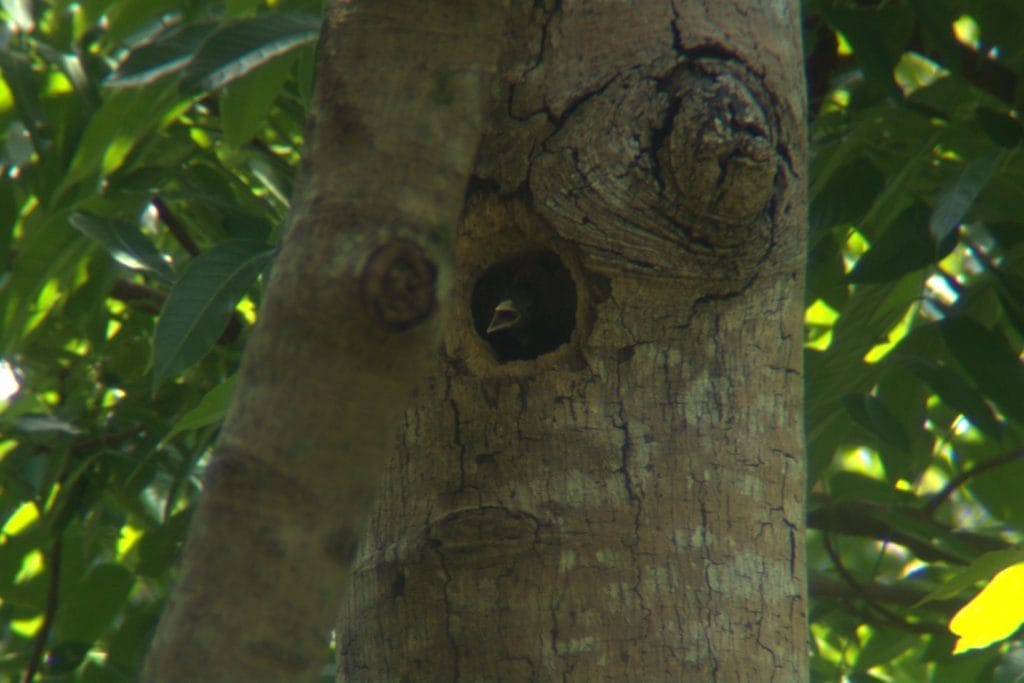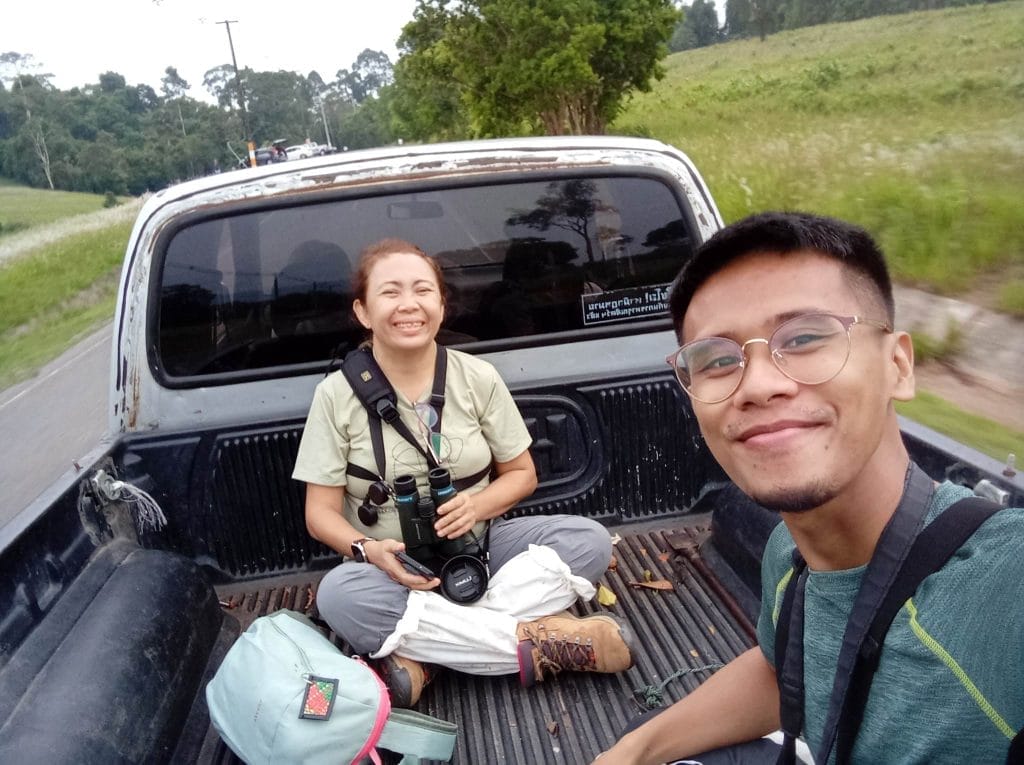By Michele T. Logarta
Two scientists from the University of the Philippines (UP)—both members of the Wild Bird Club of the Philippines—have documented for the first time the hidden life of a pair of breeding Northern Sooty Woodpeckers, a near threatened Philippine endemic species.

Entitled “First description of the breeding biology and behaviour of the near threatened northern sooty woodpecker Mulleripicus funebris (Valenciennes 1826) (Piciformes: Picidae) in Luzon Island, Philippines”, the pioneering study by Vince Angelo G. Gicaraya and Dr. Carmela P. Española, was recently published in the Natural History Sciences Journal in April this year.
Española is a leading ornithologist, wildlife biologist and professor and mentor to many, including Gicaraya, at the UP Institute of Biology (IB).
Gicaraya is a researcher in ornithology, wildlife biology and conservation science at UP IB where he teaches the subject Fundamentals of Ecology Laboratory. He is also the author of the children’s book Si Flora Tirador at ang Kaharian ng mga Ibon (Flor Tirador and the Queendom of Birds).

The study is the first ever documentation of an active nest of a pair of Northern Sooty woodpeckers and their brood of two chicks found in a standing dead Parkia timoriana tree, locally known as Cupang, at the Subic Watershed Forest Reserve, Zambales, Luzon, Philippines. Observation of the nest was conducted over a period of three months, from February to May 2022 and totalling close to 64 hours.
Gicaraya recalls spotting a male Northern Sooty woodpecker hard at work, boring a hole on a tree trunk.
“I was really mesmerized, “said Gicaraya. “Lagi ko syang binabantayan (I would constantly monitor them) and I asked myself “kelan ba sya matatapos sa pagbubutas” (When will they finish excavating)? I saw that the male would take turns with the female. it was so interesting to observe.”
After several observations, Gicaraya attempted to find out more about the woodpecker behaviour he had seen and searched existing research literature.
“Apparently, we do not have data. We don’t know how long the woodpecker would take to finish excavating the hole. We don’t know everything else related to breeding,” he said.
Gicaraya was determined to find answers to his many questions and got the approval of Española to proceed with the study.
“Woodpeckers hold a special place in my heart,” Gicaraya said in a Facebook post. “As someone who knows woodpeckers only from the cartoon The Woody Woodpecker Show and Animal Planet, I was ecstatic to see them first hand. Our site in Western Luzon even had three large ones, all equally magnificent.”
According Gicaraya, woodpeckers are understudied. Perhaps, woodpeckers are not as charismatic as other birds, like the parrots and hornbills, he speculated.
The methodology of the study was direct observation. This meant using a spotting scope to observe the activities of the birds all-day long. Gicaraya called the time spent watching the birds “Sooty Duty”.
“You are there at the vantage point where you can see them. You are there the whole day and you want to know what they do the whole day from 5:30 am to 6 pm. We were able to see parental contributions. Who is in the nest during the day? Who does what at night?”
Findings showed that both parents were involved in nest building and chick-rearing activities. The study found that “the male contributed more hours during nest building and diurnal incubation, whereas the female dominated feeding of nestlings and nest sanitation during the time of fledging,”
Gicaraya said that the study showed that the Luzon-endemic Northern Sooty Woodpecker is an “awesome dad” who probably did more to enable the female to conserve energy,
The female needs more energy for reproductive success of their clutch, said Gicaraya.
Woodpeckers are a keystone species, Gicaraya said. This means the survival of other species are dependent on them. The removal of a keystone species from an environment or habitat, such as the woodpeckers, he pointed out, would impact the other species to varying degrees.
Woodpeckers excavate holes that they use for roosting and breeding. There are many organisms such as secondary cavity-nesting birds that do not excavate, but use the holes that the woodpeckers created, Gicaraya explained.
He cited the parrots, hornbills and owls as examples of such secondary cavity-nesting bird species.
The study recommended that snags or standing dead trees be retained. Gicaraya said woodpeckers were observed to use these dead trees.
“Snags are useable to the birds and so we should not remove them,” he said. “When woodpeckers leave them, other organisms use them. In Subic, we want to see who are using the woodpecker holes and who are dependent on naturally occurring holes as well.
Finding important data to help shape conservation plans and action
The woodpecker study is just one of other research studies being undertaken by The Cavity-Nesting Bird Project, which is spearheaded by Española.
The Cavity-Nesting Bird Project aims to study the biology, ecology, ethology, and conservation of understudied cavity-nesting birds in the Philippines.
Biology, said Gicaraya, would refer to life history, breeding requirements; ecology would refer to how they use their environment for their survival.
“With this knowledge, we will be able to create conservation plans and actions,” Gicaraya said. “It will be difficult to do this without baseline information. So, if we don’t know the where and how our threatened parrots nest, then how are we going to conserve them? We need to know their behaviour.”
Research studies under The Cavity-Nesting Bird Project ask many important questions.
“We want to know clutch size, brood size, survivorship, how long does breeding take. For different bird species, these factors vary,” Gicaraya said. “What are the differences between the hornbills, the parrots and the woodpeckers?
Questions like—What fruits do they eat? What is the diversity of their diet? What are the parental /sex roles in nest creation and incubation? What influences the choice of secondary users of the cavities?—are very important.
The choice of cavity nests, research studies are showing, depends on availability of cavity characteristics. Each bird species has certain requirements for their nest. It is very interesting to know the answers to these questions and find out what are the evolutionary adaptations, Gicaraya pointed out.
Gicaraya said that they had observed racket-tails inspecting the nest holes two weeks after the woodpeckers had vacated. But, the parrots did not use the nest.
Another important puzzle the researchers want to solve is that of the “Nesting Niche”,
The question, Gicaraya said, is: Given a particular setting, is there a chance of overlapping in selection criterion and how will the competition for nesting sites affect the birds?
Previous to the woodpecker study, Gicaraya and Española scrutinized the breeding biology and nesting behaviour of the Coleto and the Asian Koel, among others
Their study on the Coleto was published in the Journal of Asian Ornithology in 2023 The study, which was the cover story of the journal as well and entitled “Notes on the breeding biology and nesting behaviour of the coleto Sarcops calvus in the wild” was again another landmark research.
According to the researchers, “it provides new information on cavity characteristics, nest material and design, and adult behaviour of the species around an active nest and adds to the limited knowledge of the biology and ecology of endemic cavity-nesting birds in the Philippines.”
The Asian Koel study, published in Ornithological Science in 2023, established a first record of parasitisation on a cavity nest identified as that of a Coleto in the Subic Watershed Forest Reserve.
The abstract of the study described the Asian Koel as an obligate brood parasite commonly known to parasitize open nests of various passerines. Previous to the study, there was no information available of the Koel’s hosts.
Gicaraya and Española are studying other cavity-nesting bird species in Subic. These are the Luzon Hornbill, Green Raquet-tail, Blue-naped parrot, Luzon Flameback, White-bellied Woodpecker, Philippine Eagle-Owl and Philippine Trogon.
Future directions for research and enriching natural history science
The joy of doing research studies in The Cavity-Nesting Bird project, said Española, is that references now exist. “There are future directions for more study that other researchers may want to pursue.”
Española and Gicaraya expressed hope to see natural history studies in the Philippines flourish.
According to Española, natural history studies are fundamental to our understanding of how the environment works.
“It focuses on where organisms are and what they do in their environment. With the degree to which humans have impacted the planet, and the overwhelming ecological problems that threaten our environmental support systems, natural history studies enables us to track to geographic and temporal changes in species and communities,” Española said. “It allows us to quantify these changes and correlate them with natural or human-related changes in the environment like climate change and pollution.”
The Cavity-Nesting Bird Project is one of the initiatives under the UP IB’s Terrestial Research in Ecology and Evolution Laboratory (TREE).
The research thrust of TREE, according to the UP IB website, is focused on taxonomy, conservation ecology and phylogenetics in terrestrial systems. Current activities of TREE include research on avian biology and ecology, terrestrial community ecology, biocultural diversity conservation, and ethnobotany.
